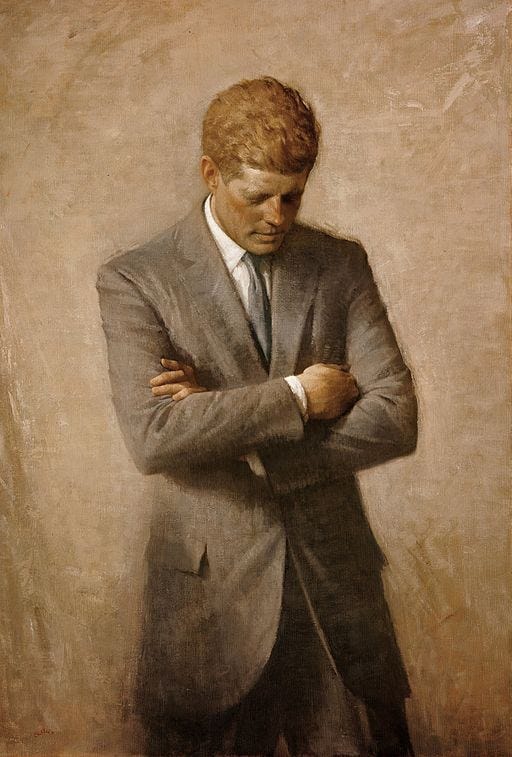Religious Freedom on the Line in 1960
The political blunder that became a symbol of religious intolerance.
A Catholic, I graduated from public high school in 1976. During those formative years, I read the magazine my parents invited into their home — Guideposts. Founded by Norman Vincent Peale to give inspiration along the lines of the Power of Positive Thinking philosophy, it was in the genre Christian although it was more generically inspirational.
Now many years later, I realized that Peale must have had some great PR. After all, he recovered from leading the charge against the election of John Kennedy because the candidate was one of us — Catholic.
Peale was one of 25 ministers who, though all Americans, met in Montreux, Switzerland to discuss the problem of having a Catholic in the White House. It was 1960 and Kennedy’s popularity was a growing concern among them including the Reverend Billy Graham. They were afraid his election would end freedom of religion and bring the Pope to be the default leader of the United States.
Norman Vincent Peale, then a leader of his Power of Positive Thinking movement, an author and a syndicated columnist writing out of his famous self-help philosophy, a mason and a Manhattan based preacher, volunteered to be the face of the effort. Rev. Billy Graham, also a strong leader, decided to stay in the background.1 Both supported Nixon in the 1960 election.
Kennedy was not the first Catholic candidate to the presidency, but the previous one did not fair too well. Al Smith, the governor of New York, lost to Herbert Hoover in 1928 because, many believe, of his Catholic faith. The anti-Catholicism that battled Smith inspired the founding of the National Conference of Christians and Jews.
Thirty-two years later, Kennedy, a Catholic, comes forward and again his Roman Catholicism becomes an issue.
In fact, according to a 1958 Harris Poll of West Virginia voters, Kennedy was well ahead of the presumed Republican candidate then Vice President Richard Nixon.
However, in 1960, weeks prior to the West Virginia primary, he was trailing fellow democrat Hubert Humphrey by twenty points. The reason? In the previous poll, voters did not know that Kennedy was Catholic.2
Kennedy’s popularity grew in 1960, this finally led to the meeting in Switzerland and the formation of The National Conference of Citizens for Religious Freedom. On September 7th 1960, Norman Vincent Peale the spokesperson for the organization, released a statement questioning Kennedy’s role of president due to his Catholic faith.
This immediately brought consternation upon Peale and upon the other ministers standing up against Kennedy’s Catholicism.
Those who condemned Peale’s statement included: former democratic president Harry Truman, The Board of Rabbis, Protestant theologian Reinhold Niebuhr and many others. Truman accused Nixon of approval of Peale’s statement. 3
Adlai Stevenson joked that the incident was proof that Nixon read The Power of Positive Thinking (ibid.)
Eleanor Roosevelt, who was not a staunch supporter of Kennedy for most of 1960, wrote in her diary two weeks later: “Religious freedom cannot just be Protestant freedom. It must be freedom for all religions.”4
Roosevelt was not against Kennedy for his faith, but for his lack of a strong statement against Senator Joseph McCarthy.
Kennedy was a senator from Massachusetts at the time and in 1956 had been hospitalized when the senate was taking up the issue of censure against Senator Joseph McCarthy. Roosevelt felt that Kennedy never formally condemned McCarthy and this and other issues led her to avoid endorsing the senator for president until late summer of 1960. Kennedy was hospitalized with serious back issues during that time. JFK’s Catholic faith never bothered her and never was a reason for her to be averse to his nomination.
The John F. Kennedy Presidential Library in Dorchester, Massachusetts maintains a series of letters from that era, some to Peale and other ministers, others to Kennedy, from not only the United States but also Canada and Europe, all angry about this lack of tolerance on the part of these clergymen.5
The letters denounced the ministers’ statements and called for an end to any form of intolerance.
One wrote his disgust from Toronto to the head of the Southern Baptist Convention in Tennessee: “We take a dim view that a man holding high responsible position as you do, would be quoted as holding such bigoted views.”
Another wrote to Peale the day after his statement: “Politics are dirty and therefore a church and thier (sic) leaders must stay clean or your teaching are (sic) nil.”
On September twelfth, five days after Peale’s announcement, Kennedy addressed the Greater Houston Ministerial Association. He affirmed to them his loyalty to the constitution of the United States and the principle of separation of church and state. He, therefore, also stood against federal funds to private and religious schools, religious figures telling people how to vote and any international figure or body dictating to the president how to act. The implication here was regarding foreign policy. 6
This statement which today is still quoted by those both for and against it, in and out of the Catholic faith, ended this dispute with The National Conference of Citizens for Religious Freedom.
Peale and the organization distanced themselves from each other by September 21 and Peale later apologized to his Manhattan congregation for getting involved in politics.
Graham also regretted his involvement.7
Kennedy obviously won the election against Nixon and the issue of a Catholic president was settled.
Catholics today still debate whether Kennedy’s position watered down their Catholic witness in the United States. However, from a strictly political perspective candidates understand Americans do not have any room for intolerance of any type.
As we continue through this election, the question can be asked again how loyal is the candidate to the Constitution of the United States, for as Kennedy made it clear, Americans want a president whose loyalty to that document is tantamount.



